David McFall R.A. (1919 - 1988)
Sculptor
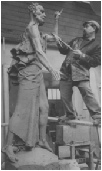
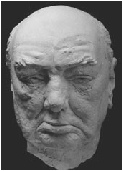
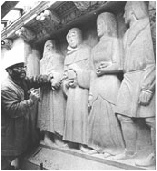
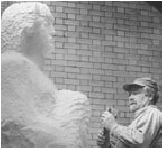

1975/4 Dancer seated on a high stool
Study of Maina Gielgud AO, ballerina, resting
Height: 23" (stool height 10½")
Bronze
Exhibited Royal Academy Summer Exhibition 1975 Catalogue No. 1338
Royal Academy Summer Exhibition Illustrated Magazine 1975 page 62
Maina Gielgud, AO
British born (14/1/1945) Maina Gielgud began ballet lessons in England with some
of the greatest artists in classical ballet of 20th Century, including Tamara Karsavina
and Stanislas Idzikowsky. At the age of twelve, she moved to France to continue her
training.  There she studied with Lubov Egorova, Victor Gsovsky and later, with Rosella
Hightower and Marika Besobrasova. Her first years as a professional dancer were
with the companies of Roland Petit, the Grand Ballet du Marquis de Cuevas, Rosella
Hightower and the Grand Ballet Classique de France, where she performed a number
of principal roles. Then followed four years with Maurice Béjart’s Ballet of the
Twentieth Century, during which time Bejart created several ballets on her, including
Bhakti, Forme et Ligne and Rose Variations, which she later danced in London. Partnering
Rudolf Nureyev in The Sleeping Beauty re-kindled her desire to dance the classics
and prompted her to join London Festival Ballet (now English National Ballet) as
a Principal Artist in 1972. During her four years there she danced all the leading
classical roles and many contemporary ones, performing in London, throughout the
UK and abroad. Her repertoire included Swan Lake, Giselle, The Sleeping Beauty, The
Nutcracker and Le Baiser de la Fée, which was specially created on her by Ronald
Hynd. In 1976 she joined The Royal Ballet’s touring company (now Birmingham Royal
Ballet) as a Guest Artist, and in 1977 re-joined as a Principal Artist. With this
Company her roles included the Black Queen in Checkmate, the Siren in Prodigal Son,
Raymonda (Act 3), La Capricciosa in The Lady and the Fool, Swanilda in Coppelia and
the Gypsy Girl in The Two Pigeons. Glen Tetley also cast her in his dramatic ballet
Gemini (which he had created on The Australian Ballet on the young Marilyn Rowe,
Carolyn Rappel, John Meehan and Gary Norman). From 1977 Maina Gielgud’s career as
a freelance dancer took her to Hungary, France, Germany, America, Brussels, and Australia
(where she danced her first Juliet in Cranko’s Romeo and Juliet (see photo next page),
and first Ashton role of Lise in La Fille mal gardée). She created her now famous
Steps, Notes and Squeaks, which was successfully premiered in London in 1978, and
later toured Australia.
There she studied with Lubov Egorova, Victor Gsovsky and later, with Rosella
Hightower and Marika Besobrasova. Her first years as a professional dancer were
with the companies of Roland Petit, the Grand Ballet du Marquis de Cuevas, Rosella
Hightower and the Grand Ballet Classique de France, where she performed a number
of principal roles. Then followed four years with Maurice Béjart’s Ballet of the
Twentieth Century, during which time Bejart created several ballets on her, including
Bhakti, Forme et Ligne and Rose Variations, which she later danced in London. Partnering
Rudolf Nureyev in The Sleeping Beauty re-kindled her desire to dance the classics
and prompted her to join London Festival Ballet (now English National Ballet) as
a Principal Artist in 1972. During her four years there she danced all the leading
classical roles and many contemporary ones, performing in London, throughout the
UK and abroad. Her repertoire included Swan Lake, Giselle, The Sleeping Beauty, The
Nutcracker and Le Baiser de la Fée, which was specially created on her by Ronald
Hynd. In 1976 she joined The Royal Ballet’s touring company (now Birmingham Royal
Ballet) as a Guest Artist, and in 1977 re-joined as a Principal Artist. With this
Company her roles included the Black Queen in Checkmate, the Siren in Prodigal Son,
Raymonda (Act 3), La Capricciosa in The Lady and the Fool, Swanilda in Coppelia and
the Gypsy Girl in The Two Pigeons. Glen Tetley also cast her in his dramatic ballet
Gemini (which he had created on The Australian Ballet on the young Marilyn Rowe,
Carolyn Rappel, John Meehan and Gary Norman). From 1977 Maina Gielgud’s career as
a freelance dancer took her to Hungary, France, Germany, America, Brussels, and Australia
(where she danced her first Juliet in Cranko’s Romeo and Juliet (see photo next page),
and first Ashton role of Lise in La Fille mal gardée). She created her now famous
Steps, Notes and Squeaks, which was successfully premiered in London in 1978, and
later toured Australia.
In 1981 she choreographed The Soldier’s Tale and in 1982 Ghosties and Goulies, for London City Ballet. She continued to appear as guest artist with various companies throughout the world until 1981 when she retired from dancing to focus on teaching, choreographing and coaching, and became Rehearsal Director of London City Ballet.
In 1983, Gielgud was appointed Artistic Director of The Australian Ballet. During her 14 years there she introduced over 40 classical and modern works to the Company’s repertoire, challenging dancers and audiences with existing and commissioned works by Australian and international choreographers, while also discovering and nurturing Stephen Baynes and Stanton Welch, whom she later appointed Resident Choreographers. She staged traditional versions of The Sleeping Beauty and Giselle, both of which were extremely successful both in Australia and on overseas tours. The Sleeping Beauty was performed at Covent Garden for the 1988 Bicentennial Gala; Giselle in 1990 at the Metropolitan Opera House New York, and again in 1992, at the Coliseum Theatre, London. The international press were unanimous in their praise of the productions’ respect for style and tradition, while demonstrating at the same time an individual approach. The company regularly toured to the dance capitals of the world, including London, New York, St Petersburg and Tokyo, receiving general acclaim from public and press, for its wide ranging repertoire, stylistic versatility and the high standard of its dancers throughout the ranks. The Australian Ballet flourished under Gielgud’s artistic directorship, and until very recently, virtually all of the company’s current Principal and Senior Artists were dancers she had developed.
In 1992, at Government House, Melbourne, in recognition of her contribution to the performing arts and particularly ballet, Maina Gielgud was appointed an Honorary Officer in the General Division of the Order of Australia. She is also the recipient of an Advance Australia Award. In 1997 Gielgud was appointed Artistic Director of The Royal Danish Ballet, where, during her two years’ tenure, she introduced a number of works to the company, including Rudolf Nureyev’s production of Don Quixote, works by Jiri Kylian, Mats Ek, Maurice Béjart and Stanton Welch. She also introduced an International Choreographic Competition, from which all four winning works were brought into the repertoire the following season.
Since 1999 Gielgud has been enjoying a free lance career as Director and Guest Repetiteur. She has taught, coached and re-staged works for several companies, including English National Ballet, Béjart Ballet Lausanne, Tokyo Ballet, Munich Ballet, The Australian Ballet and Ballet du Rhin. In 2002 she staged her production of Giselle for Boston Ballet with the original designs by Peter Farmer. The ballet received rave reviews and was highly successful. Later that same year, Gielgud made a comeback as a performer, acting and dancing the role of Winnie, with Martyn Fleming as Willy, in Maurice Béjart’s L’Heure Exquise, a variation on Samuel Beckett’s play, Happy Days. The piece received enthusiastic press, including glowing reviews by John Percival in The Independent of London, and Rene Sirvin in the Figaro of Paris. It premiered in Lausanne at the Theatre Vidy, and later toured in France and Spain. In May 2003, Gielgud staged a new production of Giselle with designs by young French designer Jean-Marc Puissant, which premiered with Ballet du Rhin in Mulhouse, France. While Artistic Associate with Houston Ballet, Maina staged Maurice Béjart’s Songs of a Wayfarer, Serge Lifar’s Suite en Blanc, as well as her own production of Giselle during the first half of 2005. They were all much acclaimed by press and audiences. During 2007 she staged Béjart’s Serait-ce la Mort for Vladimir Malakhov’s Berlin Staatsballett, and at Maurice Béjart’s invitation she re-staged Bhakti and Serait-ce la Mort and was guest teacher, for Béjart Ballet Lausanne.
Gielgud has now embarked on a regular affiliation with English National Ballet (formerly London Festival Ballet) for a number of months each year, as Guest Teacher, Coach and Repetiteur. At John Meehan’s invitation this year, she has re-staged Lifar’s Suite en Blanc for Hong Kong Ballet.
Maina Gielgud is the niece of Sir John Gielgud.
All rights reserved

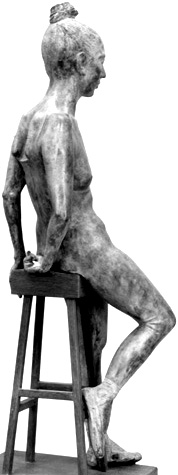

| Animals |
| Busts and Heads |
| Children |
| Churchill studies |
| Lettering |
| Medals coins plates |
| Reliefs |
| Stone carvings |
| Contemporary British Artists |
| On Epstein |
| Picasso |
| The art of portrait sculpture |
| Letters |
| Palliser |
| Son of Man |
| Press |
| Obituaries |
| Memorial address |